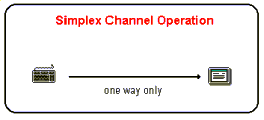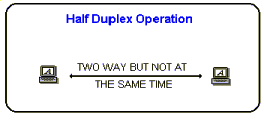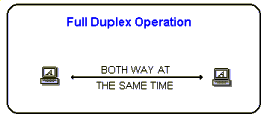![]()
DATA
COMMUNICATIONS
© Copyright Brian Brown, 1995-2000. All rights reserved.
Part 14: Simplex, Half-Duplex and Full Duplex
Simplex | Half Duplex | Full Duplex | Summary
Introduction
This section briefly discusses the modes of channel operation,
namely, simplex, half-duplex and full-duplex operation. Each is
suited a particular type of application, and has its own
advantages and disadvantages.
Objectives
At the end of this section you should be able to
Modes of Channel Operation
![]() Simplex
Simplex
Data in a simplex channel is always one way. Simplex channels are
not often used because it is not possible to send back error or
control signals to the transmit end.
 |
It's like a one way street. An example of simplex is Television, or Radio. The simplex channel also corresponds directly to Shannon's model of communication discussed earlier. |
![]() Half
Duplex
Half
Duplex
A half-duplex channel can send and receive, but not at the same
time. It's like a one-lane bridge where two way traffic must give
way in order to cross. Only one end transmits at a time, the
other end receives. In addition, it is possible to perform error
detection and request the sender to retransmit information that
arrived corrupted. In some aspects, you can think of Internet surfing as being
half-duplex, as a user issues a request for a web document, then
that document is downloaded and displayed before the user issues
another request.
 |
Another example of half-duplex is talk-back radio, and CB Radio (Citizens Band). You might have seen movies where truckies (drivers of very big trucks) communicate to each other, and when they want the other person to speak they say "over". This is because only one person can talk at a time. |
![]() Full
Duplex
Full
Duplex
Data can travel in both directions simultaneously. There is no
need to switch from transmit to receive mode like in half duplex.
Its like a two lane bridge on a two-lane highway. Have you ever
watched these television talk shows where the host has a number
of people on the show, and they all try to talk at once. Well,
that's full duplex!
 |
Of course, in the world of data communications, full duplex allows both way communication simultaneously. An example can be a consumer which uses a cable connection to not only receive TV channels, but also the same cable to support their phone and Internet surfing. All these activities can occur simultaneously. |
![]() Summary
Summary
The three modes of channel operation are
simplex, half-duplex and full-duplex.
Simple is a one way communication and there is no means of informing the sender to retransmit data in case of errors. There is however a good example of the retransmission of data, and that is TeleText, which sends text based data on top of a Television signal. A special decoder displays the Teletext data as a series of pages. These pages are sequenced and repeated, so if a page arrives corrupted, the user just needs to wait a little while till it is resent.
Half-duplex and full-duplex are the other two methods. As telephone companies become more aware of the added services that customers require, such as Internet access and Television, it is probable that a single connection to your home will provide you with a range of services, which you can use. This would require a full-duplex connection.